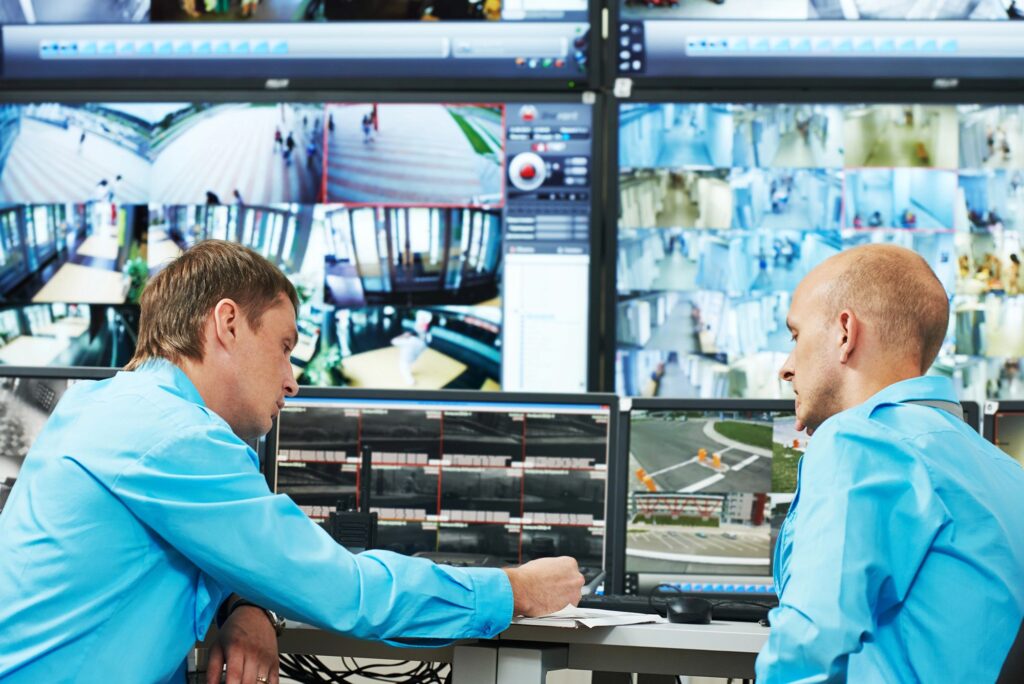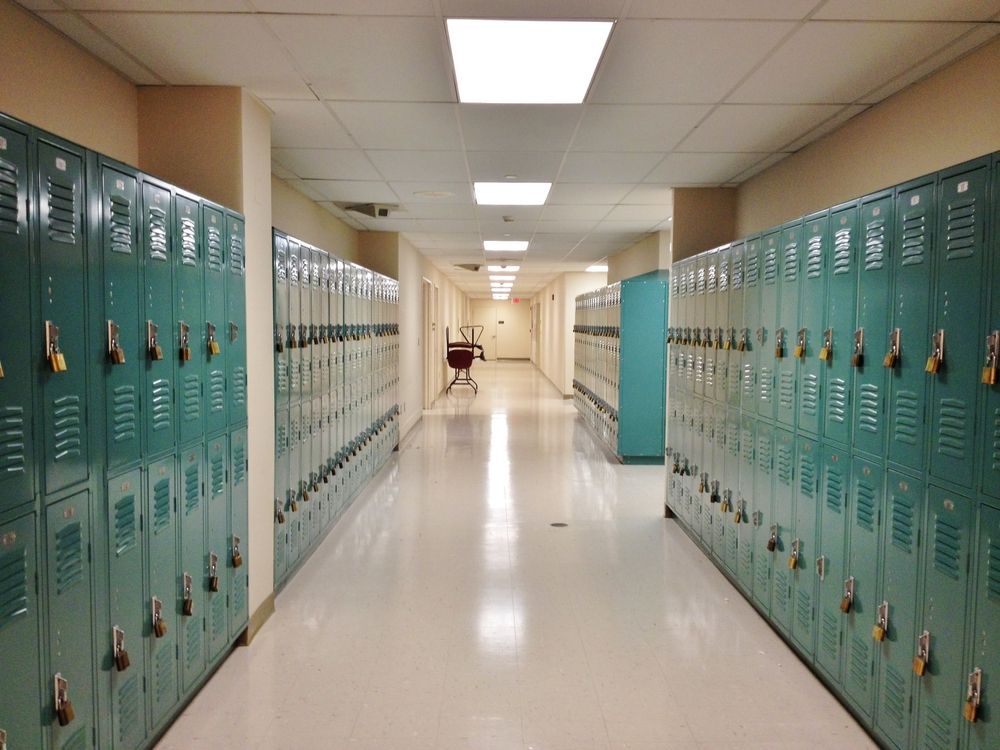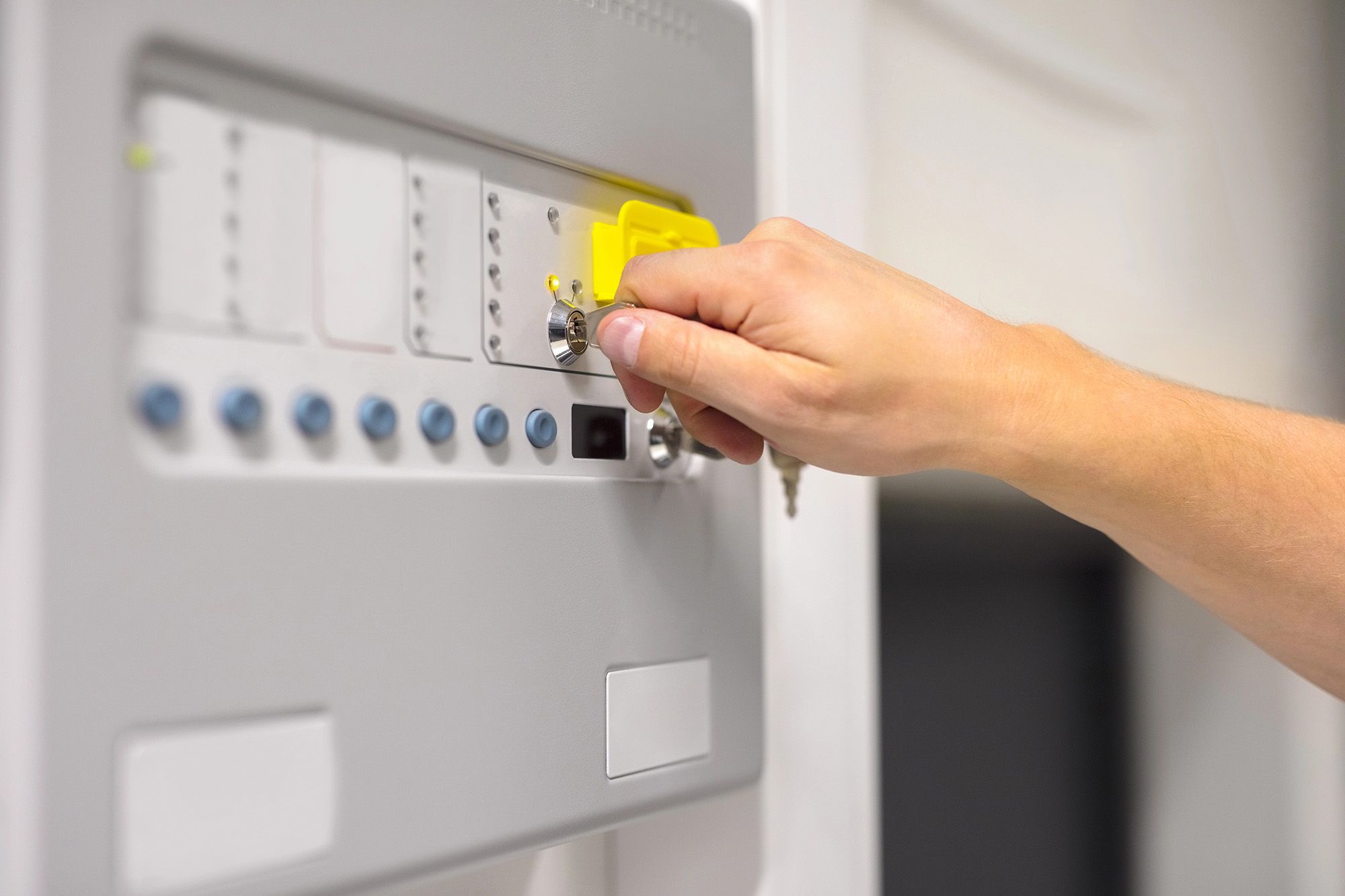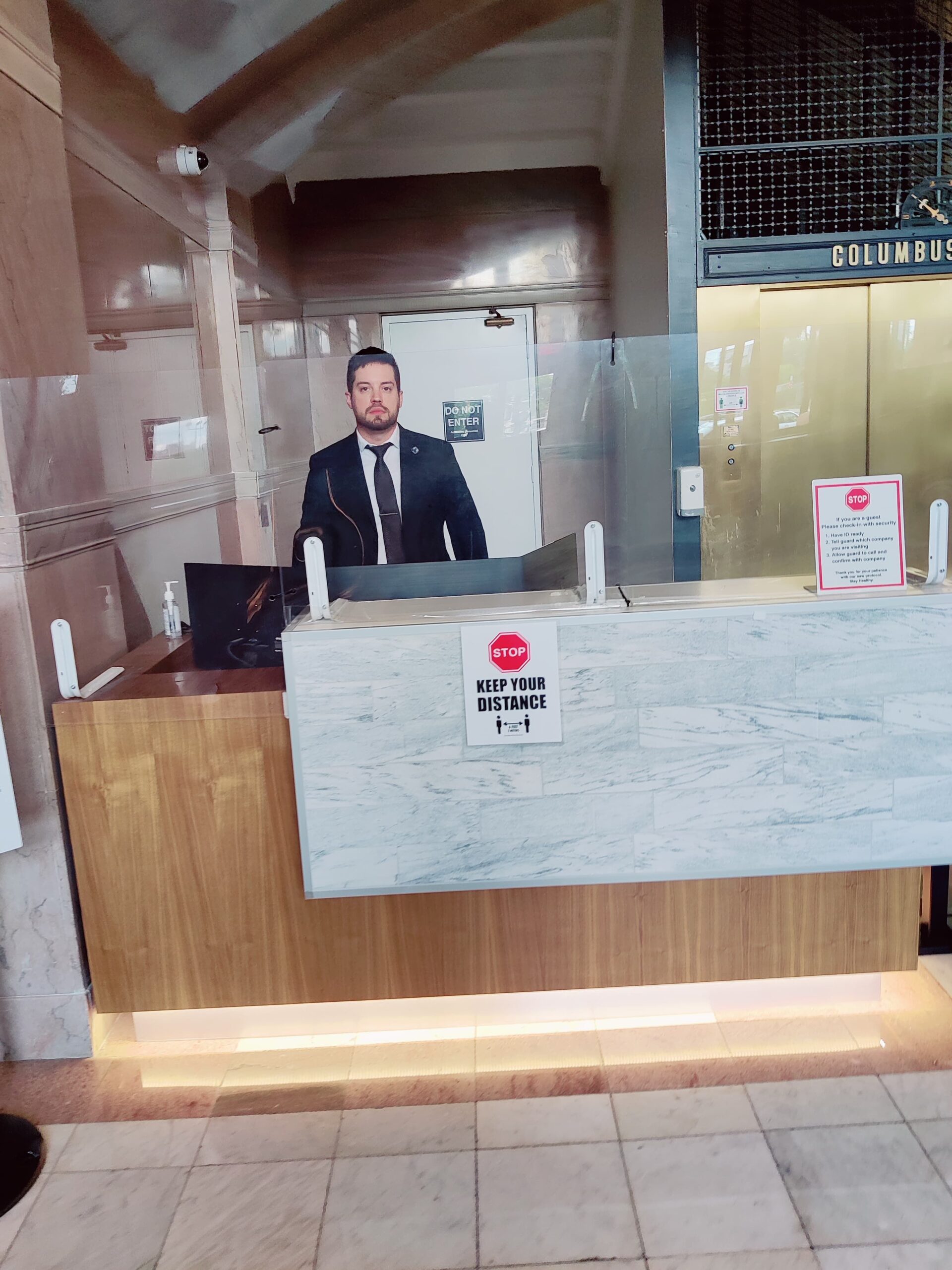Key Takeaways
- The decision between armed and unarmed security guards should be based on a thorough risk assessment of your facility, assets, and location.
- Armed guards provide enhanced protection for high-value assets and high-risk environments but come with increased costs and liability considerations.
- Unarmed guards offer cost-effective security solutions ideal for access control, monitoring, and environments where a less intimidating presence is preferred.
- Legal requirements, insurance implications, and psychological impact on employees and customers should factor into your security personnel decisions.
- Many organizations benefit from hybrid security models that strategically deploy both armed and unarmed personnel based on specific needs.

Security needs are evolving rapidly in today’s business landscape, with organizations facing increasingly sophisticated threats while simultaneously seeking cost-effective protection solutions. The traditional approach of posting unarmed security guards is being challenged by advanced remote surveillance systems that promise enhanced coverage at potentially lower costs. For businesses evaluating their security strategy, understanding the strengths and limitations of each option is crucial to making informed decisions that properly protect assets, people, and property.
Security Dilemma: Why Organizations Are Rethinking Their Protection Strategy
The security landscape has undergone a significant transformation in recent years, driven by technological advancements, shifting threat profiles, and economic pressures. Many businesses find themselves at a crossroads, questioning whether traditional security approaches still represent the best value and protection. The COVID-19 pandemic accelerated this reevaluation, as organizations sought contactless security solutions and ways to reduce operational costs while maintaining adequate protection. Budget constraints remain a primary driver behind security reassessments. With labor costs rising consistently, the expense of maintaining 24/7 guard coverage has become increasingly challenging for many organizations. Meanwhile, advancements in surveillance technology—particularly AI-powered analytics, high-definition imaging, and remote monitoring capabilities—have created compelling alternatives that promise consistent coverage without the ongoing personnel expenses. Beyond cost considerations, businesses are seeking more comprehensive security solutions that address modern vulnerabilities. The limitations of human attention span, potential for guard misconduct, and coverage gaps during shift changes have prompted security professionals to explore technology-based alternatives or hybrid approaches. This evolution isn’t simply about replacing guards with cameras, but rather finding the optimal balance between human judgment and technological capabilities to create more effective security systems.Unarmed Security Guards: The Human Element in Protection
Unarmed security personnel continue to form the backbone of many organizations’ security strategies, offering unique advantages that technology alone cannot replicate. The human element brings situational awareness, adaptive response capabilities, and interpersonal skills essential for complex security environments. Unarmed guards serve as both visible deterrents to potential wrongdoers and ambassadors for the organizations they protect, often being the first point of contact for visitors, employees, and customers. Perhaps the most significant advantage of human security personnel is their ability to make nuanced judgments in ambiguous situations—distinguishing between a legitimate emergency and a false alarm, recognizing when a situation requires de-escalation versus intervention, and adapting to unexpected circumstances. While technology excels at consistent monitoring and pattern recognition, human guards excel at understanding context and responding appropriately to the infinite variations of real-world scenarios. For more insights, explore how mobile patrol services enhance safety.What Unarmed Guards Do Day-to-Day
The responsibilities of unarmed security guards extend far beyond simply standing post or patrolling premises. Modern security officers fulfill diverse functions that combine protective services with customer service and operational support. They conduct regular security patrols, monitor access points, verify credentials, and maintain visitor logs to create comprehensive security coverage. Additionally, they often serve as first responders to medical emergencies, fire alarms, or other incidents requiring immediate human intervention.- Conducting regular patrols and inspections of the premises to identify security vulnerabilities
- Monitoring entry/exit points and verifying visitor credentials
- Responding to alarms, emergencies, and suspicious activities
- Documenting incidents and maintaining detailed security logs
- Providing customer service and directions to visitors
- Coordinating with emergency services during critical incidents
Training Requirements and Qualifications
Professional unarmed security guards undergo specialized training that prepares them for the diverse challenges they’ll face on duty. Requirements vary by jurisdiction, but typically include background checks, drug screening, and completion of state-mandated security training programs covering legal authorities, emergency procedures, and conflict de-escalation techniques. Many security firms supplement these basic requirements with additional training in customer service, emergency medical response, and site-specific protocols. The most effective security personnel combine formal training with strong interpersonal skills, sound judgment, and the ability to remain calm in high-pressure situations.Real-Time Response Capabilities
The immediate response capability of on-site security personnel remains one of their strongest advantages over technology-based solutions. When an incident occurs, unarmed guards can immediately assess the situation, determine the appropriate response, and take action—whether that means addressing the issue directly, contacting law enforcement, or evacuating an area. This real-time decision-making process happens without the delays inherent in remote monitoring systems, where alerts must be verified and response personnel dispatched from off-site locations. In critical situations where minutes or even seconds matter, having trained security staff already present can significantly impact outcomes.The Psychological Deterrent Effect
The visible presence of security personnel creates a powerful psychological deterrent that often prevents incidents before they occur. Potential wrongdoers are significantly less likely to attempt theft, vandalism, or other prohibited activities when they observe active security personnel monitoring the environment. This deterrent effect is difficult to quantify but represents one of the most valuable aspects of human security presence. The unpredictable nature of guard patrols and the knowledge that a human observer can immediately respond to suspicious behavior creates an environment where opportunistic criminals typically choose to move on to easier targets.Remote Surveillance: Technology-Driven Security Solutions
The evolution of security technology has transformed remote surveillance from simple recording devices into sophisticated, proactive security systems. Modern remote surveillance integrates high-definition cameras, advanced analytics, and real-time monitoring capabilities to create comprehensive security coverage that addresses many traditional vulnerabilities. These systems can monitor large areas continuously without fatigue, maintain consistent vigilance across multiple locations simultaneously, and create permanent records of all activities for future reference or evidence. The driving force behind this revolution has been the rapid advancement of artificial intelligence and machine learning algorithms that transform passive video feeds into intelligent monitoring systems. Where traditional CCTV required constant human attention to identify threats, today’s remote surveillance can automatically detect unusual behaviors, recognize known security risks, and alert monitoring personnel only when genuine concerns arise. This dramatic improvement in efficiency has made remote surveillance increasingly competitive with traditional guard services in terms of both effectiveness and cost. For those considering security options, understanding the choice between armed and unarmed guards can also provide valuable insights into enhancing security measures.Modern Surveillance Technologies and Capabilities
Today’s remote surveillance systems bear little resemblance to the grainy, passive cameras of previous generations. High-definition digital imaging provides crystal-clear identification capabilities even in challenging lighting conditions, while wide-angle lenses and PTZ (pan-tilt-zoom) functionality enable comprehensive coverage with fewer cameras. Advanced systems integrate multiple sensor types beyond just video, including acoustic sensors that can detect breaking glass or gunshots, thermal imaging for monitoring in complete darkness, and motion sensors that can trigger enhanced recording or alerts when activity is detected in restricted areas. Connectivity improvements have made these systems more reliable and accessible than ever before. Cloud-based storage eliminates the vulnerability of on-site recording equipment, while secure remote access allows authorized personnel to view feeds from anywhere via mobile devices or computers. Some systems even incorporate two-way audio capabilities, enabling remote security personnel to issue verbal warnings to intruders or provide instructions during emergencies. These technological advances have dramatically expanded the capabilities of remote surveillance beyond simple passive monitoring.AI-Powered Monitoring Systems
Artificial intelligence represents the most significant advancement in the effectiveness of remote surveillance. Modern AI-powered systems can distinguish between normal and suspicious activities, recognize specific individuals, identify weapons or dangerous objects, and even predict potential security threats based on behavioral patterns. These capabilities dramatically reduce false alarms while ensuring genuine security concerns receive immediate attention. The most sophisticated systems continually learn from experience, improving their accuracy over time as they analyze more security footage and incidents. Object recognition algorithms can identify abandoned packages, unauthorized vehicles, or people entering restricted areas. Facial recognition technology can alert security when known troublemakers enter the premises or verify the identity of authorized personnel accessing sensitive areas. Behavioral analytics can detect unusual movement patterns, such as loitering, erratic movements, or aggressive postures, that may indicate potential problems. All these capabilities operate continuously, without the fatigue or attention limitations that affect human monitors. For further insights into enhancing security measures, consider recommendations from physical security assessments.Remote Monitoring Centers: How They Work
The heart of effective remote surveillance is the monitoring center where trained security professionals oversee multiple client sites simultaneously. These facilities employ specialized operators who receive alerts from AI systems, review footage in real-time, and coordinate appropriate responses to security incidents. Modern monitoring centers operate 24/7/365, ensuring continuous protection regardless of holidays, weekends, or staffing challenges that might affect on-site guard coverage. The best providers maintain redundant facilities with backup power systems and multiple connectivity options to eliminate single points of failure. When suspicious activity triggers an alert, monitoring center personnel can immediately access live feeds to assess the situation. Depending on client protocols and the nature of the incident, operators might issue verbal warnings through integrated speaker systems, contact on-site security personnel or management, or dispatch law enforcement directly. This escalation process happens within seconds, often faster than an on-site guard could respond to an incident occurring in a different area of the property. The combination of AI detection and human verification minimizes both false alarms and missed security events.Installation Requirements and Technical Considerations
Implementing an effective remote surveillance system requires careful planning and professional installation to ensure comprehensive coverage without vulnerabilities. Site assessments determine optimal camera placement based on risk areas, lighting conditions, power availability, and connectivity options. Professional integrators consider environmental factors, such as weather exposure, vandalism risks, and field-of-view obstructions, when designing system layouts. For a comprehensive approach, learn about custom security protocols that guide from risk assessment to implementation. Proper installation is critical—even the most advanced equipment will fail to provide adequate protection if improperly positioned or inadequately secured. Bandwidth considerations become increasingly crucial as camera resolution increases and analytics become more sophisticated. Many modern systems employ edge computing to process video locally before transmission, reducing bandwidth requirements while maintaining analytical capabilities. Power backup systems ensure continued operation during outages, while tamper-resistant housings protect equipment from vandalism or sabotage. For maximum effectiveness, remote surveillance systems should integrate with other security measures, such as access control systems, alarm panels, and emergency notification platforms, to create a comprehensive security ecosystem.Cost Comparison: Breaking Down the Numbers
The financial equation between unarmed guards and remote surveillance represents one of the most significant factors in security planning decisions. Remote surveillance typically requires a substantial upfront investment in equipment, installation, and integration, but offers lower ongoing operational costs compared to the continuous labor expenses associated with security personnel. Guard services generally involve minimal initial investment but higher recurring costs that increase with coverage hours, number of posts, and wage inflation over time. Understanding this cost structure difference is crucial for making informed security decisions that balance both immediate budget constraints and long-term financial planning. For more insights, consider choosing between armed and unarmed guards for corporate security.Initial Investment vs. Ongoing Expenses
A comprehensive remote surveillance system for a mid-sized facility typically requires an initial investment of $15,000-$50,000 depending on camera quantity, resolution quality, analytics capabilities, and integration complexity. This upfront cost includes equipment, professional installation, system configuration, and initial training. By contrast, implementing unarmed guard coverage requires minimal startup costs—typically just background checks, uniforms, and basic equipment like radios or reporting systems. This stark difference in initial investment often presents a significant hurdle for organizations with limited capital improvement budgets, even when long-term savings would justify the expenditure.Hidden Costs You Need to Consider
Beyond the obvious expenses of wages and equipment, both security approaches entail additional costs that may not be apparent in initial quotes or budget projections. For guard services, these include overtime expenses during emergencies, replacement coverage during sick days or vacations, workers’ compensation insurance, liability coverage, recruitment costs due to turnover, and ongoing training expenses. Guard costs also typically increase annually due to wage inflation, minimum wage increases, and rising benefit costs that can significantly impact long-term budgets. For more insights on security personnel, consider choosing between armed and unarmed guards for corporate security. Remote surveillance systems incur their own hidden expenses, including software licensing fees, firmware updates, preventive maintenance, camera replacements due to environmental damage or technological obsolescence, and potential increases in monitoring fees. Network infrastructure upgrades may be necessary to support high-resolution video transmission, while cybersecurity measures must be implemented and maintained to protect surveillance systems from hacking or tampering. Understanding these less obvious costs is crucial for making an accurate financial comparison between the two security approaches.ROI Timeline: When Each Option Pays Off
For most organizations, the breakeven point between remote surveillance investment and guard services typically occurs between 12-24 months after implementation, depending on system complexity and hours of guard coverage being replaced. After this point, the ongoing savings from reduced personnel costs begin to generate a positive return on investment that compounds over time. For 24/7 coverage scenarios where three or more guard shifts would be required, the ROI timeline shortens significantly, sometimes achieving breakeven in as little as 8-10 months. However, this analysis assumes the remote surveillance system effectively addresses all security requirements previously handled by guards, which isn’t always realistic depending on specific security needs and facility characteristics.Effectiveness Face-Off: Performance Metrics That Matter
Measuring security effectiveness requires looking beyond simple cost comparisons to evaluate how well each approach prevents incidents, deters unwanted activity, and responds to security events when they occur. Organizations must consider both quantitative metrics, such as response times and false alarm rates, as well as qualitative factors, including deterrent effect and adaptability to changing circumstances. The most meaningful comparison examines performance across multiple dimensions rather than focusing on a single metric. Security effectiveness ultimately depends on matching capabilities to specific threats and vulnerabilities. Remote surveillance excels at consistent monitoring across large areas, detection of particular patterns or objects, and maintaining permanent records of all activities. Unarmed guards provide superior customer service interaction, nuanced judgment in complex situations, and an adaptable response to unexpected scenarios. Understanding these different strengths helps organizations design security programs that utilize the most effective approach for each protection requirement. For more insights, explore recommendations from physical security assessments to enhance your security strategy. Most security professionals now recognize that effectiveness comparison isn’t about choosing between technology and human personnel but rather determining the optimal integration of both elements. The question has evolved from “guards or cameras?” to “how do we strategically deploy both guards and technology to create the most effective security coverage within our budget constraints?” This hybrid mindset acknowledges that each approach has inherent strengths and limitations that must be considered in comprehensive security planning. For more insights, explore top recommendations from physical security assessments.Response Times and Incident Management
In direct response time comparisons, on-site security guards typically outperform remote surveillance when incidents occur within their immediate vicinity. A guard witnessing an event can respond instantly, while remote surveillance requires alert transmission, operator verification, and dispatch of response personnel. However, this advantage disappears when incidents occur outside the guard’s direct line of sight. Remote systems monitoring multiple areas simultaneously can often detect and respond to incidents in unattended areas faster than roving guards conducting periodic patrols. The quality of incident management also differs significantly between the two approaches. Unarmed guards can provide immediate physical assistance, perform first aid, direct evacuations, preserve evidence, interview witnesses, and coordinate with emergency responders on scene. Remote monitoring personnel are limited to observing events, communicating verbally through intercom systems if available, and dispatching appropriate response resources. This response limitation represents one of the most significant drawbacks of remote-only security approaches, particularly in scenarios that require immediate physical intervention.Deterrence Power: Which Option Scares Off More Criminals?
The visible presence of uniformed security guards creates an immediate psychological deterrent that many security professionals consider unmatched by technology alone. Potential wrongdoers can see that a human responder is present who can identify them, intervene physically, and serve as a credible witness. Studies consistently show that visible security personnel significantly reduce opportunistic crime, with some retail environments reporting reductions of 20-30% in theft incidents after implementing visible guard presence. Remote surveillance provides a unique form of deterrence through environmental cues that signal comprehensive monitoring. Prominently displayed cameras, warning signage, and occasional voice-down interventions from monitoring centers create awareness that activities are being recorded and observed. The most effective systems incorporate visible deterrence elements, such as flashing lights on cameras when motion is detected or speaker announcements when restricted areas are breached. While less immediately imposing than a human presence, these technological deterrents can cover far more area consistently and never take breaks or become distracted.Coverage Area and Limitations
Remote surveillance systems excel at providing consistent coverage across large areas simultaneously—something physically impossible for individual security officers. An adequately designed camera system can monitor multiple entry points, hallways, parking areas, and sensitive zones without the coverage gaps inherent in guard patrols. Advanced systems utilizing fisheye lenses or multi-sensor cameras can provide 360-degree visibility of large spaces with a single device. In contrast, PTZ cameras can cover expansive areas by automatically tracking movement or focusing on specific activities as needed. The limitations of remote surveillance primarily relate to physical intervention capabilities and technical vulnerabilities. Camera systems cannot physically stop an intruder, render emergency medical aid, or escort an unauthorized person from the premises. Environmental factors, such as fog, heavy rain, or extreme lighting conditions, can temporarily reduce camera effectiveness. Conversely, power outages or network failures can disable systems entirely without proper backup provisions. Understanding these limitations is crucial for developing appropriate contingency plans and complementary security measures. Unarmed guards face limitations in their coverage due to physical constraints. A single officer can only monitor what’s visible from their current position, creating inevitable blind spots in complex facilities. Even with regular patrol routes, large properties inevitably have periods where certain areas remain unmonitored between patrol cycles. These coverage gaps create vulnerabilities that sophisticated intruders can exploit, particularly in larger facilities where complete visual coverage by security personnel alone becomes cost-prohibitive.Vulnerability to Compromise or Defeat
Both security approaches face different vulnerabilities that determined adversaries might exploit. Unarmed guards may be susceptible to distraction, intimidation, or social engineering tactics that divert them away from protected assets or persuade them to grant unauthorized access. Guard effectiveness also varies significantly based on individual alertness, training quality, and personal motivation, creating potential inconsistencies in protection levels across different shifts or personnel. Remote surveillance systems are susceptible to technical vulnerabilities, including camera tampering, blind spots, lighting manipulation, or cyberattacks against networked components. Sophisticated intruders may attempt to disable cameras, exploit areas outside of camera coverage, or employ technical countermeasures, such as infrared blockers, against specific sensor types. While modern systems incorporate tamper detection and redundant coverage to mitigate these risks, understanding potential vulnerabilities remains essential for comprehensive security planning.Best-Fit Scenarios: Matching Solutions to Security Needs
The optimal security approach varies significantly based on facility type, operational requirements, threat profile, and budgetary constraints. Rather than viewing guard services and remote surveillance as competing alternatives, security professionals increasingly focus on identifying which approach—or combination of techniques—best addresses specific protection needs. Some environments naturally favor the presence of human security, while others benefit more from technology-based solutions or strategic combinations of both elements.Retail Environments
Retail settings present unique security challenges, as they must balance customer service requirements with theft prevention, cash handling risks, and high public traffic. In these environments, visible security personnel often provide significant value through both deterrence and customer assistance functions. Guards can monitor fitting rooms, observe suspicious behaviors, check receipts, and respond immediately to confrontational situations that could escalate into violence. Their presence also reassures legitimate customers and staff about their safety, contributing to a positive shopping environment. Remote surveillance complements guard services in retail by providing comprehensive coverage of sales floors, stockrooms, loading docks, and parking areas that would be impossible to monitor consistently with personnel alone. Analytics-enabled systems can automatically detect behaviors associated with shoplifting, identify known offenders through facial recognition, and alert security personnel to focus on high-risk situations. The combination of visible guards with comprehensive surveillance creates a layered defense that addresses both opportunistic theft and more sophisticated retail crime.Office Buildings and Corporate Campuses
Professional office environments typically prioritize access control, visitor management, and maintaining a welcoming atmosphere while ensuring employee safety. In these settings, unarmed security officers frequently serve dual roles as receptionists and security monitors, controlling building access, processing visitors, and maintaining situational awareness of who enters and exits the facility. Guards in corporate environments often focus more on customer service and policy enforcement than on confronting potential criminals, making interpersonal skills particularly important. Learn more about innovations in security that can enhance these environments. Remote surveillance offers excellent complementary protection for office environments by monitoring secondary entrances, parking structures, and after-hours activities when staffing levels are reduced. Integrated access control systems can automatically log entry/exit events, restrict access to sensitive areas, and create comprehensive audit trails of all building activities. The most effective office security approaches typically combine front-desk security personnel with comprehensive surveillance coverage and electronic access controls to create overlapping layers of protection.Warehouses and Industrial Facilities
Large industrial properties with extensive perimeters, valuable inventory, and hazardous operations present significant security challenges that often benefit from technology-focused approaches. The sheer size of many warehouses and manufacturing facilities makes comprehensive coverage with security personnel prohibitively expensive, while regular patrol patterns can create predictable gaps that sophisticated intruders might exploit. Remote surveillance excels in these environments by providing continuous monitoring of large areas, perimeter boundaries, and critical access points without the limitations of human observation range. The strategic deployment of guards at main entry points or during high-risk operations complements surveillance coverage by providing an immediate response capability where it is most needed. Guards in industrial settings often perform additional functions, including conducting truck inspections, verifying shipping and receiving, and monitoring for safety violations. The most effective industrial security programs typically emphasize comprehensive surveillance coverage supplemented by targeted guard deployment at critical control points rather than attempting to cover vast areas with personnel alone.Residential Communities
Gated communities, apartment complexes, and residential developments face unique security challenges, balancing resident privacy with adequate protection. In these environments, security personnel often provide valuable community relations functions beyond basic security, including package acceptance, resident assistance, rule enforcement, and serving as the public face of property management. The customer service aspect of residential security makes interpersonal skills and community engagement particularly important for guard effectiveness.The Hybrid Approach: Getting the Best of Both Worlds
The security industry has increasingly shifted toward integrated approaches that strategically combine human personnel with advanced technology rather than treating them as competing alternatives. This hybrid security model leverages the unique strengths of each component while mitigating their limitations. Remote monitoring systems provide consistent surveillance across large areas and automatically detect potential threats, while strategically deployed security personnel respond to verified concerns, handle complex interactions, and provide visible deterrence where most effective. Organizations implementing hybrid security approaches typically report higher satisfaction with overall protection levels while often achieving cost efficiencies compared to traditional guard-heavy models. The key to successful implementation lies in thoughtful system design that aligns security resources with specific risks rather than applying generic templates. Each property’s unique characteristics, operational requirements, and threat profile should drive decisions about the optimal balance between human presence and technological monitoring. For example, choosing the right security personnel can significantly enhance safety and effectiveness.Strategic Integration of Guards and Technology
Adequate hybrid security begins with a comprehensive risk assessment to identify specific vulnerabilities and protection priorities. Based on this assessment, security designers can develop targeted deployment plans that position human resources where their judgment, interpersonal skills, and physical presence provide maximum value, while utilizing technology to extend monitoring coverage across larger areas. This strategic approach often concentrates guards at main entry points, high-value assets, or public-facing areas while employing surveillance to monitor secondary entrances, perimeters, and less accessible zones. New England Security provides comprehensive risk assessments.Cost-Effective Hybrid Models
By focusing guard deployment on critical functions that genuinely require human capabilities, organizations can often reduce overall security personnel requirements while maintaining or improving protection levels. Many facilities have successfully transitioned from 24/7 multi-post guard coverage to more targeted models where guards cover peak activity periods or high-risk areas. At the same time, technology monitors the facility during lower-risk periods. This approach can reduce security labor costs by 30-50% while maintaining comprehensive protection through the intelligent use of surveillance technology. The cost-effectiveness of hybrid models improves further when considering the multiplier effect of technology-assisted guards. When supported by comprehensive surveillance and analytics, individual security officers can effectively monitor substantially larger areas than possible through direct observation alone. This force multiplication effect enables fewer personnel to provide more effective coverage, resulting in both security improvements and cost efficiencies compared to traditional approaches.Scalability Benefits
Hybrid security models offer superior scalability compared to guard-only approaches, allowing protection levels to adjust to changing requirements without proportional cost increases. Temporary coverage expansion for special events, seasonal activities, or emerging threats can be accomplished through adjustments to monitoring protocols rather than hiring additional personnel. Surveillance coverage can be quickly extended to new areas through the addition of cameras, while analytics rules can be modified to address emerging concerns without requiring extensive retraining or staffing changes. This scalability extends to multi-site operations, where centralized monitoring centers can provide consistent protection across numerous properties while local guard services address site-specific needs. National or global organizations benefit particularly from this approach, gaining standardized security operations and reporting across diverse locations while maintaining appropriate on-site response capabilities. The centralized oversight also facilitates continuous improvement through comparative analytics across properties, identifying best practices and security trends that might not be apparent when viewing locations in isolation. Perhaps most importantly, hybrid approaches can evolve as both security requirements and technologies change. Organizations can gradually adjust the balance between human and technological elements based on performance data, emerging threats, and budgetary considerations without completely overhauling their security infrastructure. This evolutionary approach allows security programs to remain aligned with current needs while incorporating new capabilities as they become available.Making the Right Choice for Your Organization
Selecting the optimal security approach requires an honest assessment of your organization’s specific protection needs, operational requirements, and resource constraints. The most effective security programs align closely with an organization’s culture and business objectives, rather than implementing generic solutions. Begin by conducting a thorough security assessment that identifies critical assets, analyzes potential threats, and evaluates existing vulnerabilities. This assessment provides the foundation for determining whether guards, surveillance, or hybrid approaches will most effectively address your specific security challenges.Frequently Asked Questions
When evaluating security options, decision-makers typically have numerous questions about implementation considerations, effectiveness comparisons, and practical concerns. Below are answers to the most frequently asked questions organizations have when comparing unarmed guard services with remote surveillance options.Can remote surveillance completely replace the need for security guards?
- For facilities with minimal public interaction and low intervention requirements, remote surveillance can potentially replace routine guard patrols.
- Properties requiring frequent visitor assistance, package handling, or immediate physical response typically still need some on-site personnel.
- Most facilities benefit from at least minimal guard presence during business hours, even with comprehensive surveillance.
- Emergency response capabilities remain significantly limited without on-site personnel.
- Customer service functions of security personnel cannot be fully replicated by remote monitoring.




